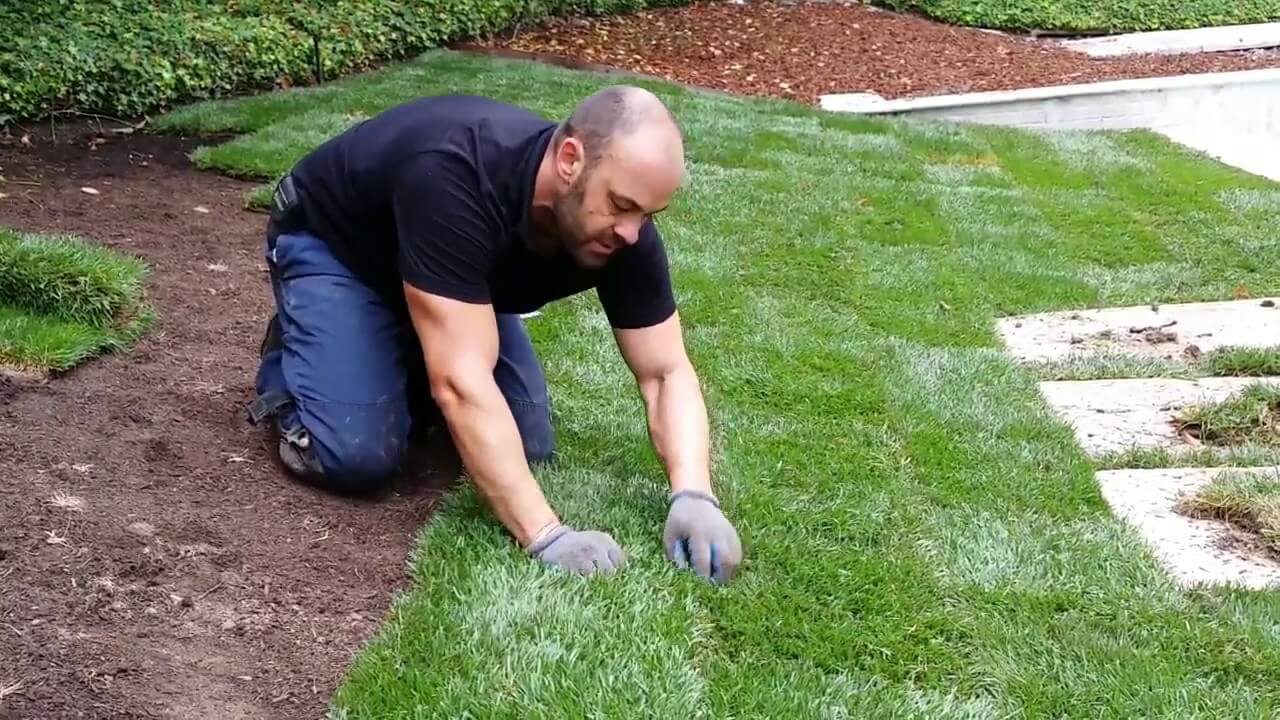Installing lush green turf on a flat level landscape is pretty straightforward. But when your lawn contains hills, mounds or angled terrain, successfully laying sod can seem intimidating. Never fear – with some adaptable techniques and smart preparation, you can create a flawless sloped lawn.
In this comprehensive guide, I’ll share the best practices for properly laying and securing turf on inclined ground so your project is a success.
Why Slopes Are Challenging for Turf
Several factors make installing and growing turf on slopes more difficult than flat lawns:
-
Water runs off quickly – Sloped areas drain faster, making it harder for grass roots to absorb moisture. More frequent watering is needed.
-
Erosion – Ground on a slope erodes more easily from rain and irrigation. Good topsoil can wash away.
-
Mowing – It’s trickier to mow a sharply angled lawn with even coverage. Weed trimmers are often needed for edges.
-
Thinning – Turf laid on an incline is more prone to thinning over time as soil and roots shift downwards.
But with smart preparation and installation tactics, these issues can be overcome and slopes can support lush, even turf.
Preparing the Slope
Proper grading and base preparation makes or breaks the success of turf on angled ground. Be sure to:
-
Loosen and smooth the topsoil to a depth of at least 6 inches for strong rooting.
-
Incorporate quality topsoil if needed to enrich the growing base.
-
For very steep slopes, install retaining walls, terraces or timber edging for support.
-
Add a 2-3 inch base layer of compacted gravel to stabilize the subsurface.
-
Cover gravel with a porous landscape fabric to prevent soil loss through the base.
Working Down The Slope
When laying sod pieces, work methodically from the top down to prevent slippage and allow drainage:
-
Begin at the highest point and orient turf along the slope (not across).
-
Place each row slightly overlapping the previous like shingles on a roof.
-
For steep grades, secure all sod edges with long turf staples as you work.
-
On slopes greater than 3:1, glue all seams for maximum hold.
Securing the Perimeter
Firmly anchoring the turf around the entire outer perimeter prevents shifting:
-
Bury edges in a trench with stakes to brace them.
-
Build a sturdy retaining border at the base for support if the incline is very steep.
-
Consider commercial slope stabilization mesh products to bolster edges.
Caring for Sloped Turf Post-Install
Once laid, gently rake the new turf and water thoroughly to encourage rooting. Overseed sparse areas and fertilize with a high-nitrogen formula to fuel establishment. Sloped lawns need extra TLC:
-
Water more frequently as slopes dry out quicker.
-
Replenish washed away topsoil to prevent further erosion.
-
Watch for signs of thinning and reseed bare patches promptly.
-
Plan to mow perpendicular to the slope to avoid scalping with the mower deck.
With the proper installation approach and some extra care, even dramatically sloped yards can grow a flawless expanse of lush, beautiful turf. The incline just requires a bit more planning and patience. Seek help laying and securing sod on steeper sections for best results. Then get ready to enjoy your scenic sloped lawn for years to come!
FAQs About Laying Turf on Slopes
How steep can a lawn be for turf?
Turf can be installed on slopes up to about a 3:1 grade (a 1 foot rise over 3 feet horizontally). Steeper than that and additional retention and stabilization is needed.
What direction should you lay sod on a hill?
Lay turf pieces lengthwise along the slope, not across. This prevents slippage. Work in horizontal rows top to bottom.
How do you prevent erosion on a sloped lawn?
Use quality topsoil, avoid over-watering, maintain thick turf, and install silt fences or straw bales on steep slopes to control erosion.
Should you stake sod on a slope?
Yes, sod on any incline over 10 degrees should be staked or stapled during install to prevent slippage. Steep slopes and sod seams always need extra anchoring.
How often should I water new sod on a slope?
New turf needs very frequent watering, up to 3-4 times daily on hot, sunny slopes. Water until the soil beneath is moist to a 3 inch depth. Reduce once the turf roots securely.
Growing gorgeous turf on angled terrain just takes some know-how and extra care. But the payoff of a lush, rolling lawn is well worth the effort. Follow these tips for successfully installing and maintaining turf on sloped areas for a lawn you’ll love.

Specification of Sods
- The sod to be laid in the slopes shall consist of dense, well-rooted growth of permanent and desirable grasses.
- The sod shall be indigenous to the locality where it is to be used.
- The sods shall be practically free from weeds and other undesirable objects.
- During the time when sod is cut, the grass on the sod shall have a minimum length of 50mm.
- The sods shall be cut in rectangular mats of uniform width, not less than about 250mm x 300mm in size.
- The thickness of the sod shall be as uniform as possible, with 50 – 80mm of soil covering the grassroots, so that all the dense roots of the grasses is retained in the sod strip.
- During wet weather, the sod shall be let to dry sufficiently to prevent rearing during handling.
- During dry weather, the sod shall be watered before lifting to ensure its vitality and prevent the dropping of the soil in handling.
Join for free or log in to continue reading…
Lost your password? Please enter your email address. You will receive a link and will create a new password via email.
Sorry, you do not have a permission to ask a question, You must login to ask question. Get the paid membership
